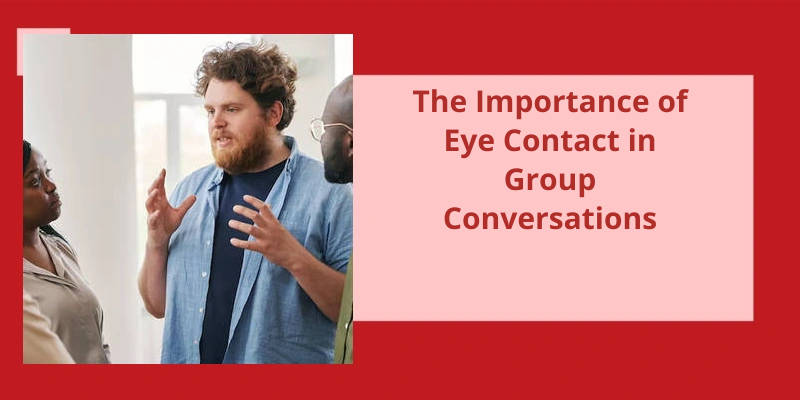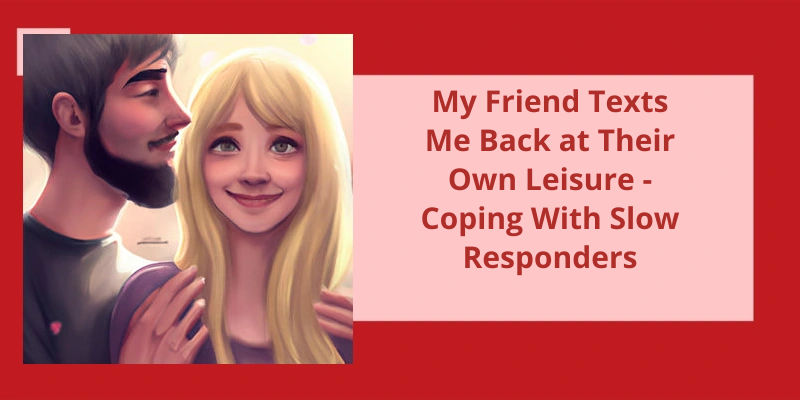It enables individuals to gauge the reactions and responses of others, ensuring a harmonious flow of conversation and allowing for a deeper level of understanding and empathy. In a world that increasingly relies on virtual platforms and digital communication, the significance of eye contact in fostering meaningful connections within group discussions can’t be understated, making it a fundamental aspect of interpersonal communication that paves the way for true understanding and cohesive collaboration.
Why Do People Look at Me When Talking to a Group of People?
Have you ever wondered why it seems that everyone looks at you when speaking in a group conversation? It’s not just your imagination – there may be a few reasons behind this phenomenon. One possibility is that you’re perceived as a leader or spokesperson within the group. Perhaps you’ve a natural presence or an authoritative demeanor that others find compelling. As a result, they instinctively look to you for guidance or validation during conversations.
In a social setting, maintaining eye contact is an important display of interest and attentiveness. By making a conscious effort to connect with each speaker, you create a comfortable and supportive environment that encourages others to open up and share their thoughts.
Furthermore, your consistent eye contact and attentive expression may offer reassurance to nervous or inexperienced speakers. The act of speaking in front of a group can be anxiety-inducing for many individuals. When they notice that you’re actively engaged and responsive to their words, it can help alleviate their uneasiness, boost their confidence, and enable them to communicate more effectively.
Additionally, your behavior might be a reflection of your own comfort zone. It’s possible that you naturally gravitate towards making eye contact and showing interest during conversations. For you, this may be an instinctive way to engage with others and establish a connection. Consequently, your behavior can influence the dynamics of the group conversation, setting a positive tone and encouraging active participation.
The Role of Body Language in Group Conversations
Body language plays a crucial role in group conversations, particularly when it comes to establishing rapport and understanding among participants. While verbal communication is important, non-verbal cues such as eye contact can greatly enhance the effectiveness of the conversation.
Eye contact helps to convey interest, attention, and engagement. When individuals make eye contact with one another in a group setting, it signals that they’re actively listening and paying attention to the speaker. This not only fosters a sense of trust and connection but also encourages others to share their thoughts and opinions.
In addition to fostering better communication, eye contact can also serve as a means of non-verbal feedback. It can indicate agreement, disagreement, confusion, or interest, which allows for better understanding of group dynamics and overall engagement.
It’s important to note that cultural norms and individual preferences may influence the comfort level and perceived meaning of eye contact. Being mindful of these differences can help create a more inclusive and effective group conversation.
Maintaining eye contact while speaking to a group is crucial for effective communication. Rather than fixating on one person, it’s essential to engage with multiple individuals by utilizing the 3-second method of direct eye contact. Pausing briefly to glance at the entirety of the group further establishes a connection and ensures everyone feels included.
Who to Look at When Speaking to a Group?
When participating in a group conversation, it’s crucial to understand the significance of eye contact. Knowing who to look at and when can have a profound impact on the effectiveness of your communication. Glancing at the faces of group members allows you to establish a connection and engage with individuals on a personal level.
However, it’s essential to strike a delicate balance. Staring at someone can make them uncomfortable, so avoid fixating your gaze on one person for an extended period. Instead, employ the 3-second method, wherein you maintain direct eye contact for a brief but meaningful interval. This technique ensures that you connect with people without making them feel scrutinized.
To create a sense of inclusivity and engagement, try to make eye contact with multiple individuals throughout the conversation. By scanning the group, you convey that each persons presence and input are valued. This technique not only makes the conversation more collaborative but also encourages active participation from everyone involved.
While maintaining individual connections is important, it’s equally crucial to periodically glance at the entire group. This broader gaze helps you gauge the overall dynamics, ensuring that everyone feels included and understood. It allows you to read the room and adapt your communication accordingly, whether it’s emphasizing important points or inviting others to contribute.
Remember, eye contact is a powerful non-verbal tool that can convey empathy, understanding, and trust. So, look into the eyes of your audience, meet their gaze, and let your eyes do the talking.
Source: What can I do if I’m speaking to a group of people? …
It’s a simple gesture but one that can make a world of difference in how conversations are perceived. Eye contact is a universal language, signaling respect and engagement, regardless of gender. Whether it’s a guy or girl, making eye contact while talking shows that you value their words and are genuinely interested in what they’ve to say. So, do girls like it when a guy makes eye contact while talking to them? Absolutely. But let’s dive deeper into the reasons why this small act can have a big impact.
Do Girls Like It When a Guy Makes Eye Contact While Talking to Them?
Eye contact is an essential aspect of effective communication in group conversations. While it’s true that making eye contact is often associated with romantic interest, it’s significance extends far beyond that context. Girls, like anyone else, appreciate it when someone maintains eye contact while talking to them. It conveys a sense of respect and establishes a meaningful connection between the individuals involved.
It demonstrates that you’re giving them your undivided attention, creating a sense of validation and making them feel valued. This can foster a deeper level of connection and understanding, ultimately enhancing the quality of the conversation.
It helps in maintaining the flow of the conversation and ensures that everyone has an equal opportunity to participate. By making eye contact, you’re signaling that you’re ready to contribute or respond, creating a harmonious and inclusive environment for everyone involved.
By maintaining eye contact, you aren’t only showing that you’re engaged and present, but also creating an environment that encourages open dialogue and active participation.
The Impact of Eye Contact on Building Trust and Rapport in Professional Settings
Eye contact plays a significant role in building trust and rapport in professional settings. When engaged in a group conversation, maintaining eye contact demonstrates that you’re actively listening and paying attention to what others are saying.
By making direct eye contact, you convey openness and honesty, which helps to establish trust among participants. It also shows respect and engagement, creating a positive impression and enhancing the quality of interaction.
Furthermore, eye contact fosters a sense of connection and understanding. It allows for nonverbal cues to be exchanged, such as nods, smiles, and other facial expressions, which can strengthen the bond between individuals in a group conversation.
In contrast, avoiding eye contact or consistently looking away can convey disinterest, lack of confidence, or even dishonesty. This can hinder effective communication and diminish the trust and rapport that’s essential for successful collaboration and teamwork in professional environments.
In conclusion, eye contact is a powerful tool that contributes to the establishment of trust, rapport, and effective communication in group conversations. By maintaining eye contact, individuals can foster a positive atmosphere, enhance understanding, and build stronger professional relationships.
This behavior, commonly observed in social interactions, reflects the preference to establish a strong connection and engage in meaningful conversation. By maintaining consistent eye contact with the individual they find most captivating, people convey their interest and prioritize a deeper level of connection. Interestingly, this phenomenon isn’t determined solely by personal closeness, but rather an inclination towards stimulating and enjoyable conversations.
Why Do Some People Only Look at One Person When Talking?
In group conversations, it’s fascinating to observe how individuals engage with one another through eye contact. One intriguing behavior is when some people only look at one person while talking. This phenomenon can be attributed to various factors. Firstly, individuals often make eye contact with the person they’ve a strong affinity for in the conversation. This person may be someone they feel particularly connected to or enjoy conversing with on a personal level.
Secondly, the one they gaze into the eyes of might be the individual they find the most captivating when discussing a specific topic. This persons opinions or insights may resonate deeply with them, making them more inclined to maintain consistent eye contact. It’s natural for individuals to seek out those who can intellectually stimulate or challenge them, resulting in increased eye contact with such individuals.
Additionally, personal interest can greatly influence eye contact patterns. People tend to make extended eye contact with individuals they’re romantically interested in or attracted to. Similarly, someone may find a specific persons ideas, stories, or perspectives particularly intriguing, leading to increased eye contact during conversations. In these cases, looking into their eyes can be a way to express and reciprocate interest or admiration.
Furthermore, the dynamics within the group may contribute to this behavior. This can be driven by a desire to please, seek approval, or establish a connection with the person in focus.
The Effects of Technology on Eye Contact Patterns: Consider How the Rise of Video Conferencing and the Use of Screens in Conversations May Affect Eye Contact Behaviors, Potentially Altering the Way People Communicate and Engage With One Another Visually.
- Increased reliance on video conferencing may reduce the amount of direct eye contact between individuals during conversations.
- The use of screens during conversations can create a physical barrier that hinders eye contact.
- Technology may lead to a shift in eye contact behaviors, with individuals more likely to focus on the screen rather than each other.
- Reduced eye contact can impact social cues and the perception of trust and engagement in communication.
- People may become more comfortable with limited eye contact when communicating through screens, potentially affecting interpersonal connections.
- Technology advancements, such as virtual reality, may further alter eye contact patterns by introducing new ways of communication that differ from traditional face-to-face interactions.
- Further research is needed to understand the long-term effects of technology on eye contact and it’s implications for interpersonal relationships.
It’s crucial to understand the subtle nuances of eye contact, as it can reveal a person’s emotions, intentions, and level of engagement in a conversation. While too little eye contact may suggest submissiveness, excessive eye contact can come across as intimidating or overly dominant. Striking the right balance is key in establishing trust and effective communication.
What Does Lack of Eye Contact Indicate?
In group conversations, the importance of eye contact can’t be overstated. It serves as a powerful nonverbal cue that can convey a multitude of messages. One of the key indicators is the lack of eye contact, which can reveal a lot about a persons intentions and emotions. Generally, a lack of eye contact when someone is speaking communicates submission, disinterest, or even insecurity. It suggests that the individual may lack confidence in their ideas or feel uncomfortable being the center of attention.
Moreover, avoiding eye contact when questioned or queried is often seen as a sign of deceit. The inability or reluctance to meet someones gaze during such moments can indicate that the person is withholding information or trying to hide something. It can be a red flag that urges others to probe further or question the authenticity of the persons statements.
When individuals actively make eye contact with others in a group conversation, it shows that they’re attentive, involved, and interested in what others have to say. This nonverbal gesture conveys respect, empathy, and a willingness to listen.
Conclusion
It enhances communication, fosters connections, and promotes active engagement among participants. The act of looking into each other's eyes creates a sense of trust and understanding, allowing for better collaboration and idea sharing within the group. Moreover, maintaining eye contact helps individuals gauge reactions, pick up on non-verbal cues, and ensure effective message delivery. This fundamental practice ultimately cultivates an inclusive and productive group dynamic, enabling participants to feel heard, valued, and connected.






